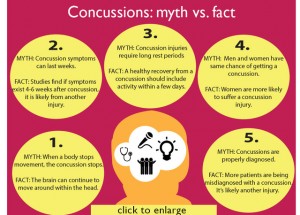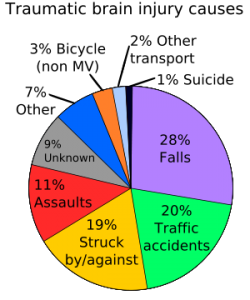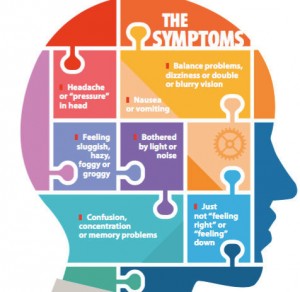
www.Mothersagainstconcussions.org
A concussion is a mild traumatic brain injury (TBI). It occurs from either a direct blow to the head or elsewhere on the body that results in an impulsive force transmitted to the head. This can happen if you are in a car accident, while participating in sports or any time that you hit your head. A TBI can cause a disturbance in brain function and information processing. Brain functions that control one’s coordination, learning, memory, and emotions are most commonly affected by a concussion injury.
A concussion can present with a wide array of symptoms that may or may not include:
- Altered mental status including confusion, inappropriate emotions, agitation or abrupt change in personality
- Blurred vision/double vision/seeing stars or black spots
- Dizziness, poor balance or unsteadiness
- Excessive or persistent headache
- Excessive fatigue/feel slowed down
- Feel “in a fog”
- Loss of consciousness
- Amnesia/memory problems
- Loss of orientation
- Vomiting
- Poor balance/coordination
- Ringing in ears
- Excessive sensitivity to light or loud noise
- Vacant stare/glassy eyed
Every person is unique and may not have the same symptoms as someone else that has had a concussion. If you or someone you know has experienced a direct hit to the head or forceful hit to the body causing their head to whip, watch for these concussion symptoms.
Some of these symptoms may appear right away, while others may not be noticed for days or months after the injury, or until the person starts resuming their everyday life and more demands are placed upon them. Sometimes, people do not recognize or admit that they are having problems. Others may not understand their problems and how the symptoms they are experiencing are impacting their daily activities.
www.salina.com
Most concussions heal without issues or complications if handled properly. However, like any other injury, a brain injury should be given time to heal. Time to heal includes both physical and mental rest (free from mental straining and visual stimuli like video gaming and texting).
One of the most severe complications of brain trauma is intracranial bleeding or the development of a hematoma. The skull has no ability to expand to allow for brain swelling. If bleeding or swelling of the brain occurs, pressure in the skull rises and can cause brain injury. Hematomas develop immediately after an injury or hours later, so monitoring symptoms is critical. Bleeding from a brain injury can be life threatening. It is important to see a doctor or go to the emergency room after sustaining a concussion to be checked out, especially if lose of consciousness has occurred.

Almost half a million patients ages 14 years and younger visit emergency rooms annually for this type of injury, with children ages 0-4 and 15-19 years old having the highest incidence of annual traumatic brain injury (TBI) related emergency department visits, hospitalizations and deaths. Children are thought to be at a higher risk for concussion injuries when compared to adults due to anatomical and structural differences, such as head shape and size, brain water content, vascularization, myelination, and weaker neck muscles. Falls account for the largest number of TBIs, sports-related concussions are a great concern, with an estimated 3.8 million sports or recreation-related concussions occurring annually, accounting for 8.9% of high school injuries. Football is the leading cause of concussion in high school athletes, followed by girls’ soccer, boys’ lacrosse, and boys’ soccer (Gillooly, 2016).
Repeated mild TBIs occurring over an extended period of time (i.e., months, years) can result in cumulative neurological and cognitive deficits. Repeated mild TBIs occurring within a short period of time (i.e., hours, days, or weeks) can be catastrophic or fatal.
Second Impact Syndrome (SIS) involves a second concussion occurring before the individual has recovered from their first concussion. Many studies have shown that even after the initial post-concussion symptoms disappear, the athlete is still extremely vulnerable, and the likelihood of re-activating symptoms hours or even days later with possible accompanying neurological deficit is highly likely. If an athlete returns to play before healing then they could cause further damage and prolong symptoms of the concussion. Even more serious than this are the consequences of chronic concussions, which include: Post-Concussion Syndrome (PCS) and Chronic Traumatic Encephalopathy (CTE). It is therefore important to get an accurate diagnosis for a concussion as soon as possible (Kazemi, 2016).
For information on how to prevent TBI and the potentially serious effects from this injury, please visit the TBI Prevention page.
https://www.cdc.gov/traumaticbraininjury/index.html
References
Gillooly, D. (2016). Current Recommendations On Management of Pediatric Concussions.
Pediatric Nursing, 42(5), 217-222.
Kazemi, M. (2016). Concussion assessment and management knowledge among
chiropractic fourth year interns and residents. Journal Of The Canadian Chiropractic
Association, 60(4), 273-285.
https://www.cdc.gov/traumaticbraininjury/index.html

